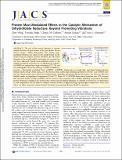Files in this item
Protein mass-modulated effects in the catalytic mechanism of dihydrofolate reductase : beyond promoting vibrations
Item metadata
| dc.contributor.author | Wang, Zhen | |
| dc.contributor.author | Singh, Priyanka | |
| dc.contributor.author | Czekster, Clarissa M. | |
| dc.contributor.author | Kohen, Amnon | |
| dc.contributor.author | Schramm, Vern L. | |
| dc.date.accessioned | 2020-05-22T11:30:07Z | |
| dc.date.available | 2020-05-22T11:30:07Z | |
| dc.date.issued | 2014-06-11 | |
| dc.identifier | 256400368 | |
| dc.identifier | c6c68c7c-35a6-46a2-a750-71a937343763 | |
| dc.identifier | 000337336800033 | |
| dc.identifier | 84902258731 | |
| dc.identifier.citation | Wang , Z , Singh , P , Czekster , C M , Kohen , A & Schramm , V L 2014 , ' Protein mass-modulated effects in the catalytic mechanism of dihydrofolate reductase : beyond promoting vibrations ' , Journal of the American Chemical Society , vol. 136 , no. 23 , pp. 8333-8341 . https://doi.org/10.1021/ja501936d | en |
| dc.identifier.issn | 0002-7863 | |
| dc.identifier.other | ORCID: /0000-0002-7163-4057/work/59222334 | |
| dc.identifier.uri | https://hdl.handle.net/10023/19984 | |
| dc.description | This work was supported by NIH research grants GM068036 (V.L.S.) and GM65368 (A.K.), and NSF grant CHE-0133117 (A.K.). | en |
| dc.description.abstract | The role of fast protein dynamics in enzyme catalysis has been of great interest in the past decade. Recent “heavy enzyme” studies demonstrate that protein mass-modulated vibrations are linked to the energy barrier for the chemical step of catalyzed reactions. However, the role of fast dynamics in the overall catalytic mechanism of an enzyme has not been addressed. Protein mass-modulated effects in the catalytic mechanism of Escherichia coli dihydrofolate reductase (ecDHFR) are explored by isotopic substitution (13C, 15N, and non-exchangeable 2H) of the wild-type ecDHFR (l-DHFR) to generate a vibrationally perturbed “heavy ecDHFR” (h-DHFR). Steady-state, pre-steady-state, and ligand binding kinetics, intrinsic kinetic isotope effects (KIEint) on the chemical step, and thermal unfolding experiments of both l- and h-DHFR show that the altered protein mass affects the conformational ensembles and protein–ligand interactions, but does not affect the hydride transfer at physiological temperatures (25–45 °C). Below 25 °C, h-DHFR shows altered transition state (TS) structure and increased barrier-crossing probability of the chemical step compared with l-DHFR, indicating temperature-dependent protein vibrational coupling to the chemical step. Protein mass-modulated vibrations in ecDHFR are involved in TS interactions at cold temperatures and are linked to dynamic motions involved in ligand binding at physiological temperatures. Thus, mass effects can affect enzymatic catalysis beyond alterations in promoting vibrations linked to chemistry. | |
| dc.format.extent | 9 | |
| dc.format.extent | 1959522 | |
| dc.language.iso | eng | |
| dc.relation.ispartof | Journal of the American Chemical Society | en |
| dc.subject | QD Chemistry | en |
| dc.subject | BDC | en |
| dc.subject | R2C | en |
| dc.subject.lcc | QD | en |
| dc.title | Protein mass-modulated effects in the catalytic mechanism of dihydrofolate reductase : beyond promoting vibrations | en |
| dc.type | Journal article | en |
| dc.contributor.institution | University of St Andrews. School of Biology | en |
| dc.contributor.institution | University of St Andrews. Biomedical Sciences Research Complex | en |
| dc.identifier.doi | https://doi.org/10.1021/ja501936d | |
| dc.description.status | Peer reviewed | en |
This item appears in the following Collection(s)
Items in the St Andrews Research Repository are protected by copyright, with all rights reserved, unless otherwise indicated.

